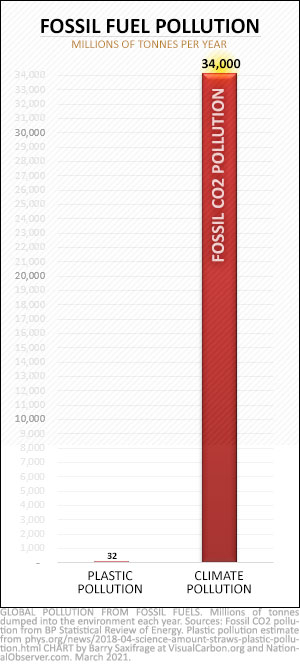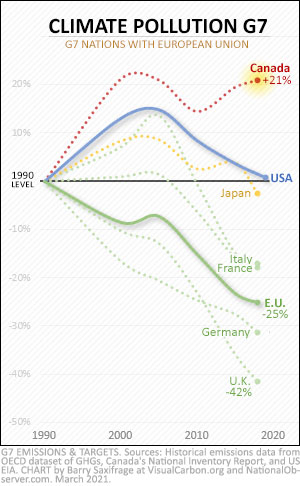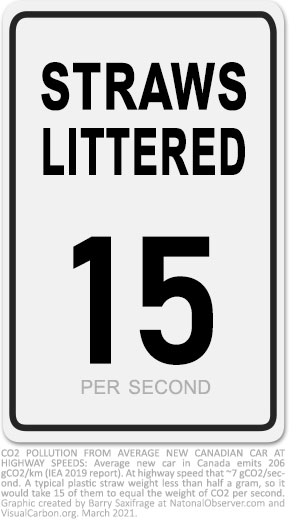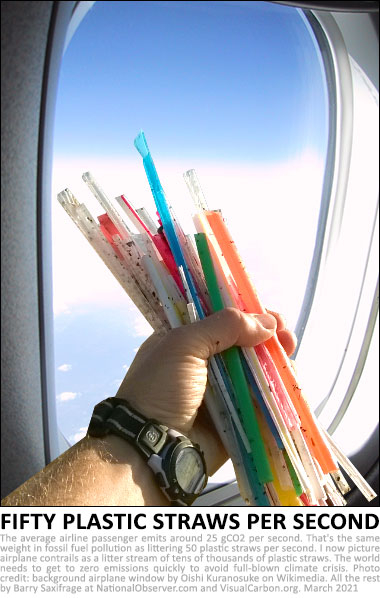I have littered the equivalent of 15 plastic straws every second, for hours on end, day after day. That's how much climate pollution our family car littered out its tailpipe on the highway. But I didn't appreciate how shockingly huge my polluting was because I couldn't see it. Once I started picturing my fossil fuel CO2 as the equivalent amount of fossil fuel plastic litter, it completely changed my understanding of our climate pollution emergency, and my motivation to do something positive about it.
Climate pollution's invisibility cloak has allowed Canadians, like myself, to emit dangerously huge amounts without even noticing. Here's a visual carbon tour of what we are doing and some of the plastic litter visualizations I use to make it real to me.
Most of us know what the plastic pollution crisis looks like. Roadsides littered with plastic bags, beaches strewn with plastic detritus, and heartbreaking photos of animals choking on, or entangled in, plastic trash. It's a visceral, in-your-face problem. And the quantities are huge — up to 32 million tonnes of it per year, by one estimate.
Unfortunately for the continued safety of our species, the climate pollution we are dumping into our air and oceans is a thousand times greater. But this particular form of fossil fuel pollution — CO2 — is invisible to humans. That invisibility cloak has allowed societies, businesses, and individuals to release hugely dangerous amounts, without seeing what we are doing.
Out of sight, out of mind and out of control

As my first chart shows, humans are dumping 34 billion tonnes of fossil fuel CO2 pollution into our climate system each year.
In comparison, our rampant plastic pollution, as huge as it is, is barely visible on the chart.
Humanity's out-of-sight fossil fuel CO2 pollution has grown so massive, it is starting to geo-engineer our planet.
Roughly half of what we emit stays in the atmosphere, acting like zombie heat pumps. These pump an additional 400,000 atomic bombs worth of energy every day into our already destabilized climate system. All that added energy is starting to super-size wildfires, droughts, storms, flooding, extreme heat, and is destabilizing major ecosystems.
Roughly a quarter of our CO2 pollution dissolves into our oceans, where it has caused a 30 per cent rise in acidity. That's already causing widespread harm to many forms of marine life. And if we continue with business-as-usual fossil fuel burning, within the lifetime of today's kids, ocean acidification levels are projected to reach a level last seen millions of years ago in the Miocene, fuelling a global extinction event.
Out of sight, out of mind. Out of control.
The great Canadian disconnect
Here in Canada, the stealth mode of CO2 has allowed us to become troublingly disconnected from our actions.
Polling shows most Canadians want Canada to be a climate leader. That's heartening and unsurprising. But those polls also show that most Canadians think we are helping lead the way.
Our actual CO2 emissions tell a different story. Out of 200 nations, Canada is one of the top 10 worst climate polluters — in both total emissions and per person.

And despite 33 years of promising to pollute less, we're still heading in the wrong direction. Our failure to cut our emissions has left us far behind many of our international peers.
As my chart on the right shows, Canada is the only G7 nation still emitting well above our 1990 levels. And we're the only one that increased emissions over the last decade.
Despite the reality of our emissions, polls show Canadians think we are doing almost as well as Germany, and much better than the United Kingdom. In reality, Germany has cut its emissions by 32 per cent since 1990, and the U.K. cut its by 42 per cent. We cranked ours up by 21 per cent.
Climate scientist James Hansen has repeatedly warned about CO2's invisibility posing a serious barrier to public understanding of the crisis, lamenting: "It’s not like 1970 when the public could see pollution in the air and in the water."
But what if we could see our climate pollution?
But what if we could see our climate pollution — just like we do our plastic pollution? Would we be acting more forcefully to save ourselves from it?
In my case, the answer was an unexpectedly compelling "yes."
I initially struggled to understand my own fossil fuel CO2, let alone the much larger quantities emitted in our society. That all changed one day when I started picturing CO2 as littered plastic.
Here's how I see it now.
A fistful of plastic straws

I started by picturing CO2 as the plastic straws I saw littered about.
A typical single plastic straw weighs less than half a gram. So, I use two littered plastic straws as my visual stand-in for each gram of CO2 (gCO2).
For larger amounts, I often picture a fistful. The photo on the right, shows 50 straws I picked up while walking along a plastic-choked tide line. That's my visual stand-in for 25 gCO2.
With those "plastic straw equivalents" in my mind, I started using them to visualize my two biggest direct sources of CO2 at the time — our family car and our jet travel.
Plastic straws out the tailpipe

One of our largest and most out-of-control climate pollution sources in Canada is burning fossil fuels for transportation. And the lion's share of the damage comes from the gasoline we buy at the pump.
For many Canadians, burning gasoline in their car or truck is their single-biggest direct source of CO2.
Our family car back then was a Subaru wagon. It burned gasoline right at the Canadian average — around 210 gCO2 per kilometre.
Polluting the average amount seemed reasonable to me until I started to "see" that CO2 as equal to littering 420 plastic straws every kilometre.

At highway speed, the average Canadian car litters climate pollution at the rate of 15 plastic straws' worth shooting out the tailpipe — every second.
Of course, if we threw fistfuls of plastic litter out our car windows, it would persist in the environment for centuries, piling up and doing harm. So, few of us would ever do that.
At the same time, the CO2 we litter out our tailpipes can persist for centuries in our air, fuelling climate change, and tens of thousands of years acidifying the oceans. But because the climate pollution coming out of my car was invisible to me, I didn't even notice what I was doing.
Now, however, when I drive on busy highways, I "see" this fossil fuel CO2 as thousands of plastic straws flying out of tailpipes and piling up in monumental drifts along the roadside. It didn't take my partner and I long to decide that our "average" Canadian car was far too polluting for us.

More recently I've learned that the average new Canadian car is actually the world's most climate polluting, littering 206 gCO2 per kilometre. Would we be doing this if we could see all our tailpipe pollution?
Some popular vehicles that pollute at this 400-straws-per-km rate include versions of Toyota RAV4, Ford Fusion, Honda Accord, Nissan Rogue, Subaru Outback, Kia Soul and VW GTI.
And our biggest fossil fuel burning pickups and SUVs can burn and emit twice as much.
What about filling up at the pump? Every 50 litres generates another 250,000 plastic straws worth of climate pollution out the tailpipe.
And over the entire lifespan of our average Canadian car, I realized we'd need a lot of those fill ups — enough to buy 21 tonnes of gasoline. Those 130 barrels in my graphic on the right are the actual amount of gasoline each will burn. Burning that would litter three million fistfuls of plastic straws worth of extremely persistent climate pollution. Yikes. I would feel bad littering just one handful of plastic straws out my window. Three million?! What were we doing?
Today, our family car doesn't have a tailpipe. It runs on made-in-B.C. electricity instead of burning gasoline. Thanks in part to strong climate policies enacted more than a decade ago, B.C.'s electricity is currently 100 times less climate polluting to drive on than gasoline. Using it to fuel our car litters around four plastic straws worth of climate pollution every kilometre instead of the 400 caused by burning gasoline.
Reducing climate pollution 99 per cent like this must happen with everything we do. But it is also sobering to realize that even that last one per cent is still too much. The climate science is clear that the only way to prevent a full-blown climate crisis is to quickly get to zero emissions everywhere.
So, I’m still visualizing those remaining four plastic straws per kilometre to keep myself focused on the critical need to get them down to zero as well.
Plastic straws at 30,000 feet
Our family car wasn't our biggest source of climate pollution back then. Our jet travel was worse. Indeed, getting on a fossil-fuel burning jetliner is probably the quickest way anyone can inject climate pollution into the environment.

The average airline passenger emits around 25 gCO2 — a fistful of 50 plastic straws worth — every second.
The last time I took a flight, I tried to visualize what it would look like if we all had to physically throw our fossil fuel pollution out the window. It was a sweaty, frenzied scene as everyone struggled to jettison fistful after fistful of plastic, non-stop, throughout the entire flight. Mildly humorous. Definitely disturbing.
People choosing premium-class seats can pollute two to five fistfuls per second. Or more. Private jet? Averaging 10 times the CO2 per passenger, you'll want to bring a snow shovel to help jettison the plastic straws fast enough.
A single long-haul flight can inject more than a million plastic straws worth of climate pollution per passenger into the upper atmosphere. Now when I see contrails, I picture them as tens of thousands of plastic straws littered in the jetliner's wake.
And that's just the CO2 part. The full climate damage caused by burning jet fuel at high altitude looks to be two to three times worse when additional climate warming from contrails clouds and from other pollutants like black carbon soot are counted.
I used to love the luxuries provided by rapid, long-distance jet travel. Sometimes I miss them.
But I love the pleasures of thriving ecosystems and a stable climate even more. And I can already see these being destroyed by our climate pollution. Once I started "seeing" the scale of my jet fuel pollution, too, I wanted off.
I haven't been on an airliner for a decade and a half since. And, sadly, the airline industry's refusal to reduce its soaring climate pollution makes it unlikely I'll get back on board.
Littered plastic bags per day
I'll wrap up this visual carbon tour with one example using plastic bags that I think about often. A typical plastic shopping bag weighs about six grams. So, my visual stand-in for each kilogram of CO2 (kgCO2) is 165 littered plastic bags.

As mentioned above, we Canadians are one of the world's top 10 worst climate polluters per capita. We emit an average of 16 tonnes of CO2 from fossil fuel burning each year. That works out to 44 kgCO2 every day.
As with other climate pollution statistics, I couldn't really relate to these quantities until I pictured it as each Canadian littering 7,400 plastic bags. Every day.
I tried to picture myself littering thousands of plastic bags each day into my local forests and farm fields, playgrounds and parks, lakes and beaches.
It didn't feel like climate leadership to me.






Comments
Excellent illustration!
The biggest visible straws in Canada are oil pipelines transporting crude and refined products from AB: east, west, but mostly south. Canada exports about four-fifths of its crude oil production, almost all of it to the U.S.
Enabling year-over-year expansion of production in Canada's fastest growing emissions sector: the oilsands. Our biggest invisible straw.
Upstream oil & gas is Canada's top-emitting sector. Nominally* 26.5% of the national total (2018). Ahead of transportation.
The oilsands is Canada's fastest-growing source of emissions.
With rapid expansion, the oilsands will account for an increasing share of Canada's carbon budget. This one industry generates more emissions than all of BC. AB's emissions are already far higher than Ontario's.
AB's fraudulent 100+ Mt oilsands cap represents more than two thirds of Canada's 2050 target (150 Mt). (Now advertised as net-zero.)
Add conventional oil & gas emissions. Add the rest of AB's outsize emissions. AB alone will explode Canada's 2050 target.
Exclude the oilsands, and AB's emissions are still 7.5x the global average and 2.5x the national average.
Even using the industry's gross under-estimates, Canada's oilpatch is the FOURTH MOST CARBON-INTENSIVE on the planet, behind Algeria, Venezuela, and Cameroon. Canada's rating is nearly twice the global average.
Rystad Energy: "Among the top 10 oil and gas producing countries, Canada had the highest CO2 emission intensity per barrel of oil equivalent."
Canada's average crude carbon intensity is more than twice the global average. Almost double Iran. Nearly triple Russia. More than triple the U.S. 4x Saudi Arabia and Qatar. 5.5x Norway and the UAE.
*As study after study based on actual measurements shows, Canada's oil & gas industry grossly under-reports its emissions. So its actual emissions comprise an even greater share of the national total.
Good points, as always, Geoffrey. Those pipelines are indeed some very big "straws" pouring climate pollution into our collective future. Last time I did the math, Canadians export fossil fuels at the rate of 32 tCO2-worth per capita each year. That's double the amount we emit at home.
Excellent. But what's this about electric cars creating 1% of the GG?!? I've heard 30% in many other places. Watch that misinformation.
Thanks for the comment, Rob. The 1% in the article is about the CO2 created by the energy used to fuel the vehicles. For gasoline that is 264 gCO2/kWh of energy. For BC electricity it is 10 gCO2/kWh. And EV's only require 1/4 as much energy to move so that knocks BC electricity down to 2.5 gCO2/kWh-equivalent -- or 1%. Quebec and Manitoba electricity is even cleaner. Hope that clarifies.
Hi Barry,
It's kind of astounding how much energy modern internal combustion engines expend in heat - only 20-35% of energy remaining is left to transfer to the wheels to move the car forward. I think that this is a major weakness for folks who wish to sequester carbon from the air using electricity and then turn it back into carbon-neutral fuel. I suspect we'd need 10x electricity to achieve the same number of 'driving hours' as a straight-up electric car. Curious if you've done any of the math on this?